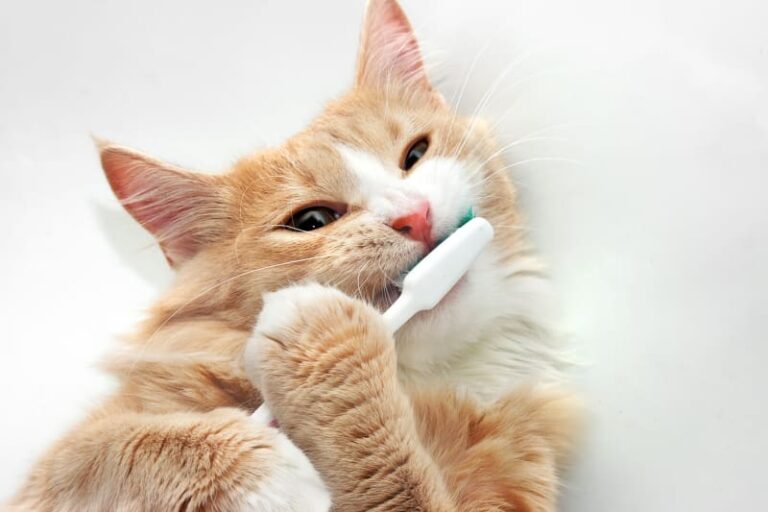Do you want to ensure that your furry friend has healthy teeth and gums? Brushing your cat’s teeth is an essential part of their dental care routine. Not only does it help maintain their oral health, but it also prevents common dental issues that can cause discomfort and pain. By following a few simple steps, you can learn how to brush your cat’s teeth effectively.
Firstly, it is important to introduce your cat to the toothbrush and toothpaste gradually. Start by letting them sniff and lick the toothpaste, which should be specifically formulated for cats. Once they are comfortable with the taste, you can begin the brushing process. Use a soft-bristled toothbrush or a finger brush designed for cats. Gently lift their lips and brush in circular motions, focusing on the outer surface of the teeth. Be sure to praise and reward your cat throughout the process to make it a positive experience.
Brushing your cat’s teeth should be done at least two to three times a week. It is essential to be patient and consistent to ensure their dental health. Remember, prevention is always better than cure, and by incorporating regular brushing into your cat’s routine, you can help them maintain a healthy and happy smile for years to come.
Benefits of Brushing

- Preventing Dental Diseases: Just like humans, cats can develop dental diseases such as periodontal disease and gingivitis. Regular brushing helps remove plaque and tartar buildup, reducing the risk of these diseases.
- Reducing Bad Breath: If your cat has a case of unpleasant breath, brushing can help freshen their breath. It eliminates bacteria and food particles that contribute to bad breath.
- Improving Oral Hygiene: Brushing your cat’s teeth ensures better overall oral hygiene. It helps maintain healthy gums, reduces the risk of tooth loss, and promotes a healthier mouth.
Remember, introducing brushing slowly and gradually is key to success. Start by getting your cat comfortable with the idea of having their mouth touched. Then, slowly introduce a toothbrush and toothpaste specifically designed for cats. With patience and regular brushing, you can help your feline friend maintain a healthy and happy smile.
Choosing the Right Toothbrush and Toothpaste

As for toothpaste, never use human toothpaste as it can be toxic to cats. Instead, choose a toothpaste formulated specifically for feline dental care. These toothpastes are available in various flavors that cats find appealing, such as poultry or seafood flavors. Introduce the toothpaste gradually to your pet by letting them lick a small amount from your finger. This will help them get accustomed to the taste and texture.
When introducing the toothbrush, allow your cat to sniff and investigate it first. Then, gently lift their lip and brush their teeth using circular motions. Focus on the outer surfaces of the teeth, as that’s where plaque and tartar tend to accumulate. Be patient and calm during the brushing process, rewarding your cat with praise and treats afterwards. With time and practice, brushing your cat’s teeth will become a routine part of their dental care regimen.
Frequently Asked Questions
Q: How often should I brush my cat’s teeth?
A: It is recommended to brush your cat’s teeth at least 2-3 times a week to maintain good dental health.
Q: Can I use a regular toothbrush for my cat?
A: No, it is best to use a toothbrush specifically designed for cats. These toothbrushes have softer bristles and a smaller head, making it easier to reach all areas of your cat’s mouth.
Q: What type of toothpaste should I use?
A: Never use human toothpaste as it can be toxic to cats. Instead, use toothpaste formulated specifically for cats. These toothpastes come in flavors that cats enjoy, such as poultry or seafood.
Q: How do I introduce toothbrushing to my cat?
A: Start by gradually introducing your cat to the toothbrush and toothpaste. Let them sniff and lick the toothpaste to get familiar with the taste. Then, slowly introduce the toothbrush by gently rubbing it on their teeth and gums. Make sure to reward your cat with praise or treats for their cooperation.
Q: What if my cat refuses to let me brush their teeth?
A: If your cat is resistant to toothbrushing, try using alternative dental products such as dental wipes or dental sprays. These can help reduce plaque and freshen breath. However, it’s still important to consult with your veterinarian for the best dental care options for your cat.
